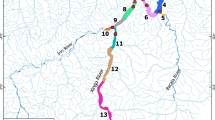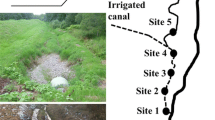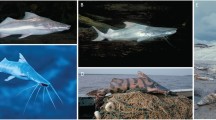Abstract
Following flooding peaks in the Beni River, a massive upstream migration event involving juvenile pencil catfish (Trichomycterus barbouri) or chipi chipi is described for the first time. The annual migration begins in the floodplains of the Beni River, where enormous schools of juveniles form to travel upstream through the straits of the last foothills of the Andes into Andean foothill forest streams and rivers. Observations and local knowledge suggest a migration distance of at least 370 km over an average of 32 days in February and March with an average speed of 12 km/day. The migrating juveniles weigh less than 0.38 g and measure less than 33 mm in standard length. As such, considering body length and body weight to distance travelled ratios they are one have one of the greatest migration efforts of any freshwater fish. Local people harvest juveniles across the migration route, but especially in Rurrenabaque, where they are considered a seasonal dish. This scientific revelation highlights the Amazon as a place where natural phenomena are still being discovered, described and documented in an era when hydroelectric infrastructure threatens the ecology of many aquatic ecosystems.









Similar content being viewed by others
References
Araujo-Lima C, Goulding M (1997) So fruitful a fish. Ecology, conservation, and aquaculture of the Amazon’s tambaqui. Columbia University Press
Araújo-Lima C, Oliveira E (1998) Transport of larval fish in the Amazon. J Fish Biol 53:297–306
Arratia G (1983) Trichomycterus chungarensis n. sp. and Trichomycterus laucaensis n. sp. (Pisces, Siluriformes, Trichomycteridae) from the high Andean range. Stud Neotropical Fauna Environ 18:65–87
Arratia G, Menu Marque S (1984) New catfishes of the genus Trichomycterus from the high Andes of South America (Pisces, Siluriformes) with remarks on distribution and ecology. Zool Jahrb Abt Syst Ökol Geogr Tiere 111(4):493–520
Arraya M, Maldonado M, Carvajal-Vallejos FM, Fernández L (2009) Contribución al conocimiento de los peces del género Trichomycterus (Siluriformes: Trichomycteridae) en los Andes de Bolivia. Revista Boliviana de Ecología y Conservación Ambiental 45–52
Barthem R, Goulding M (1997) The catfish connection: ecology, migration, and conservation of Amazon predators. Columbiua University Press, New York City
Bauer S, Hoye BJ (2014) Migratory animals couple biodiversity and ecosystem functioning worldwide. Science 344:1242552. doi:10.1126/science.1242552
Brower LP, Malcolm SB (1991) Animal migrations: endangered phenomena. Am Zool 31:265–276
Burgess WE (1989) An atlas of freshwaters and marine Catfishes, a preliminary survey of the Siluriformes. Tfh Productions Inc
Carolsfeld J, Harvey B, Ross C, Baer A (2003) Migratory fishes of South America. IDRC
Carvajal-Vallejos F, Fernández AJZ (2011) Diversidad y distribución de los peces de la Amazonía boliviana. In: Los peces y delfines de la Amazonía boliviana: hábitats, potencialidades y amenazas. Editorial INIA. Cochabamba, Bolivia pp 101–147
CIPTA, WCS (2010) La pesca en el territorio Takana. La Paz, Bolivia
De Lima ÁC, Araujo Lima C (2004) The distributions of larval and juvenile fishes in Amazonian rivers of different nutrient status. Freshw Biol 49:787–800
Eigenmann CH (1911) Description of a new species of Pygidium. Annals Carnegie Mus VII:214–215
Eigenmann CH (1918) The pygidiidae, a family of south American catfishes. Mem Carnegie Mus 7:259–398
Fernandez LA (1996) Nuevas localidades para Trichomycterus roigi (Pisces: Siluriformes: Trichomycteridae) en las provincias de Salta y Jujuy (Argentina). Neotropica 42:121–122
Fernández LA (2000) Redescription of the teleost Trichomycterus barbouri (Eigenmann, 1911), occurrence in Argentina and comparison with related species (Ostariophysi: Siluriformes: Trichomycteridae). Stud Neotropical Fauna Environ 35:27–33. doi:10.1076/0165-0521(200004)35:1;1-M;FT027
Fernández L, Miranda G (2007) A catfish of the genus Trichomycterus from a thermal stream in southern South America (Teleostei, Siluriformes, Trichomycteridae), with comments on relationships within the genus. J Fish Biol 71:1303–1316. doi:10.1111/jfb.2007.71.issue-5
Fernandez L, Schaefer S (2003) Trichomycterus yuska, a new species from high elevations of Argentina (Siluriformes: Trichomycteridae). Ichthyol Explor Freshwaters 14:353–360
Fernández L, Vari R (2004) New species of trichomycterus from midelevation localities of Northwestern Argentina (Siluriformes: Trichomycteridae). Copeia 2004:876–882
Fernández L, Vari RP (2012) New species of Trichomycterus (Teleostei: Siluriformes) from the Andean Cordillera of Argentina and the second record of the genus in thermal waters. Copeia 2012:631–636
García Vásquez A, Alonso JC, Carvajal F et al (2009) Life-history characteristics of the large Amazonian migratory catfish Brachyplatystoma rousseauxiiin the Iquitos region, Peru. J Fish Biol 75:2527–2551. doi:10.1111/j.1095-8649.2009.02444.x
Gautier E, Brunstein D, Vauchel P et al (2006) Temporal relations between meander deformation, water discharge and sediment fluxes in the floodplain of the Rio Beni (Bolivian Amazonia). Earth Surf Process Landf 32:230–248
Glantz MH (2005) Climate variability, climate change, and fisheries. Cambridge Univ Pr
Gomes L, Araujo-Lima C, Chippari-Gomes AR, Roubach R (2006) Transportation of juvenile tambaqui (Colossoma macropomum) in a closed system. Braz J Biol 66:493–502
Goulding M, Carvalho ML (1982) Life history and management of the tambaqui (Colossoma macropomum, Characidae): an important Amazonian food fish. Rev Bras Zoologia 1:107–133
Henderson PA (2005) The growth of tropical fishes. In: Val AL, de Almeida e Val VMF, Randall DJ (eds) Fish physiology: the physiology of tropical fishes. Academic, New York
Jellyman DJ (1977) Summer upstream migration of juvenile freshwater eels in New Zealand. N Z J Mar Freshw Res 11:61–71. doi:10.1080/00288330.1977.9515661
Junk WJ (1984) Ecology of the “várzea“, floodplain of Amazonian white-water rivers. In: Sioli H (ed) The amazon: limnology and landcape ecology of a mighty tropical river and its basin. Dr. Junk Publishers, Dordrecht, p 763
Junk W, Bayley P, Sparks R (1989) The flood pulse concept in river-floodplain systems. Can Spec Publ Fish Aquat Sci 106:110–127
Lucas MC, Baras E (2001) Migration of freshwater fishes. Blackwell Science
McConnell R, Lowe-McConnell RH (1987) Ecological studies in tropical fish communities. Cambridge University Press, New York, USA
McGlauflin MT, Schindler DE, Seeb LW et al (2011) Spawning habitat and geography influence population structure and juvenile migration timing of sockeye salmon in the wood river lakes, Alaska. Trans Amer Fish Soc 140:763–782. doi:10.1080/00028487.2011.584495
Miller KA, Fluharty DL (2005) El Niño and variability in the northeastern Pacific salmon fishery: implications for coping with climate change. In: Glantz MH (ed) Climate variability, climate change and fisheries. Cambridge University Press, Cambridge
Milner-Gulland EJ, Fryxell JM, Sinclair ARE (2011) Animal migration. Oxford University Press, New York, USA
Miranda G, Pouilly M (1999) Ecología comparativa de poblaciones superficiales y cavernícolas de Trichomycterus spp. (Siluriformes) en el Parque Nacional de Torotoro. Rev Boliviana Ecología Conservación Ambients 6:163–171
Miranda-Chumacero G (1999) Adaptaciones Biológicas y Ecológicas de Peces del Género Trichomycterus al Ambiente Cavernícola en el Parque Nacional Torotoro. Tesis de Licenciatura en Biología, UMSA. La Paz
Miranda-Chumacero G (2006) Distribución altitudinal, abundancia relativa y densidad de peces en el Río Huarinilla y sus tributarios (Cotapata, Bolivia). Ecologia Bolivia 41:79–93
Miranda-Chumacero G (2007) Plan de manejo para la cosecha experimental de peces ornamentales en la TCO-Takana. WCS - Bolivia. Consejo Indigena del Pueblo Tacana, La Paz
Pearson NE (1924) The fishes of the eastern slope of the Andes. I. The fishes of the rio Beni basin, Bolivia, Collected by the Mulford Expedition. Indiana University Studies XI (64): 1–83
Petrere M Jr, Barthem RB, Córdoba EA, Gómez BC (2005) Review of the large catfish fisheries in the upper Amazon and the stock depletion of piraíba (Brachyplatystoma filamentosum Lichtenstein). Rev Fish Biol Fish 14:403–414. doi:10.1007/s11160-004-8362-7
Pouilly M, Miranda G (2003) Morphology and reproduction of the cavefish Trichomycterus chaberti and the related epigean Trichomycterus cf. barbouri. J Fish Biol 63:490–505. doi:10.1046/j.1095-8649.2003.00171.x
Pouilly M, Lino F, Bretenoux J, Rosales C (2003) Dietary–morphological relationships in a fish assemblage of the Bolivian Amazonian floodplain. J Fish Biol 62:1137–1158
Pouilly M, Barrera S, Rosales C (2006) Changes of taxonomic and trophic structure of fish assemblages along an environmental gradient in the Upper Beni watershed (Bolivia). J Fish Biol 68:137–156
Pouilly M, Jégu M, Camacho J, et al. (2010) Lista actualizada y distribución de los peces en las tierras bajas de la Amazonía Boliviana. Revista Boliviana de Ecología y Conservación Ambiental 73–97
Prchalova M, Vetesnik L, Slavik O (2006) Migrations of juvenile and subadult fish through a fishpass during late summer and fall. Folia Zool 55:162–166
Ribeiro M (1983) As migrações dos jaraquis (Pisces, Prochilodontidae) no Rio Negro, Amazonas, Brasil, 192 pp. Tese de Mestrado, Instituto Nacional de Pesquisas da Amazônia, Manaus
Trajano E (1997) Food and reproduction of Trichomycterus itacarambiensis, cave catfish from south-eastern Brazil. J Fish Biol 51:53–63
Vendel A, Chaves P (2006) Use of an estuarine environment (Barra do Saí lagoon, Brazil) as nursery by fish. Rev Bras Zoologia 23:1117–1122
Welcomme RL (1979) Fisheries ecology of floodplain rivers. Longman Press, New York
Welcomme RL (1985) River fisheries. FAO Fisheries Technical Paper, 262, 330 pp
Winemiller KO, Jepsen DB (2004) Migratory neotropical fish subsidize food webs of oligotrophic blackwater rivers. Food webs at the landscape level University of Chicago Press, Chicago, Illinois 115–132.
Yuma M, Maruyama A, Rusuwa B (2000) Behavior and distribution of upstream-migrating juvenile Rhinogobius sp. (the orange form). Ichthyol Res 47:379–384
Zapata LA, Usma JS (2014) Guía de las especies migratorias de la biodiversidad en Colombia. Peces. Ministerio de ambiente y Desarrollo Sostenible y WWF Colombia, Bogotá, Colombia
Zuanon J, Sazima I (2005) Free meals on long-distance cruisers: the vampire fish rides giant catfishes in the Amazon. Biota Neotropical 5:109–114
Acknowledgments
The Wildlife Conservation Society through the Greater Madidi Landscape Conservation Program funded this research. We extend our particular thanks to the network of voluntary observers in local communities, without whose interest, curiosity and responsibility this work would not have been possible: Juan “Tonchi” González (Carmen del Emero), Eduardo Cabinas (Cachichira), Crisanto Serato (Copacabana), Constantino Nay (San Miguel), Juan “Masaco” Buchapi and Eddy Ocampo (Rurrenabaque). Fieldwork was also greatly assisted by Gober Serato and Eddy Ocampo and family. We would also like to thank Julio Pinto and Rubén Marín of the Institute of Ecology and Limnology Department for their constant support in the execution of this study and their collaboration for our research was conducted with the correspondent approval of the Biodiversity Authorities (MMAyA-VMABCCGDF-DGBAP - N° 354/2014. Luis Fernández, Luis Pacheco, two anonymous revisers and the editor made valuable suggestions of this manuscript for which we are extremely grateful. This work is dedicated to the Tacana people, in whose territory this phenomenon occurs along with others yet to discover.
Author information
Authors and Affiliations
Corresponding author
Electronic supplementary material
Below is the link to the electronic supplementary material.
ESM 1
(MP4 176242 kb)
Rights and permissions
About this article
Cite this article
Miranda-Chumacero, G., Álvarez, G., Luna, V. et al. First observations on annual massive upstream migration of juvenile catfish Trichomycterus in an Amazonian River. Environ Biol Fish 98, 1913–1926 (2015). https://doi.org/10.1007/s10641-015-0407-3
Received:
Accepted:
Published:
Issue Date:
DOI: https://doi.org/10.1007/s10641-015-0407-3




